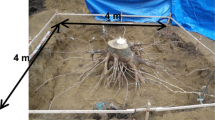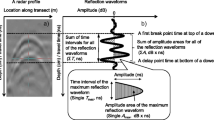Abstract
Aim
Ground-penetrating radar (GPR) has been used for estimating root biomass, estimating pull-out resistance force of roots, and reconstructing root system architecture. Although GPR can estimate the diameter of a single root, it has not yet been verified whether it can successfully estimate the diameters of adjacent roots or whether rock fragments occurring in the soil matrix can be misidentified as roots. This study aimed to (1) evaluate the visual properties of GPR images of root bundles and rock fragments, and (2) clarify whether they have the potential to create non-negligible errors in GPR surveys.
Methods
Root bundle samples buried in a sandy soil bed were scanned using 900 MHz and 1500 MHz antennas. Sole roots of Cryptomeria japonica and rock fragments in the bed were also scanned.
Results
A bundle of root formed one hyperbola with an apex in the radar profile, like a sole root. However, the contrast of the hyperbolas was weak and GPR indices relating to diameter were reduced compared to those of the comparably sized sole root. Stones did not form clear images, but boulders were faintly visible with non-negligible GPR indices.
Conclusions
For evaluation of root biomass, adjacent roots had the potential to lead to significant errors. Similarly, in reconstructions of root system architecture, adjacent roots might lead to incorrect modelling of root point connections, because of incorrect diameters. For pull-out resistance force, adjacent roots could lead to only underestimation, i.e., safe-side error. Misidentification of rock fragments as roots depends on their sizes.






modified from Tanikawa et al. 2013a). a A representative reflected hyperbola in a radar profile of a target (a wooden dowel) buried at a depth of 30 cm; b the reflection waveforms and the four waveform indices extracted in this study: the sum of the time intervals between zero crossings for all of the reflection waveforms (∑T, ns); the time interval between zero crossings of the maximum reflection waveform (Single Tmax, ns); the sum of the amplitude areas for all of the reflection waveforms (∑A, dB × ns); and the amplitude area for the maximum reflection waveform (Single Amax, dB × ns)




Similar content being viewed by others
Abbreviations
- A :
-
Amplitude area
- ∑A :
-
Sum of amplitude areas for all reflection waveforms
- Single A max :
-
Amplitude area of the maximum reflection waveform
- GPR:
-
Ground-penetrating radar
- T :
-
Time interval between zero crossings
- ∑T :
-
Sum of time intervals for all reflection waveforms
- Single T max :
-
Time interval for the maximum reflection waveform
References
al Hagrey SA (2011) Geophysical imaging techniques. In: Mancuso S (ed) Measuring roots, an updated approach. Springer, Berlin, pp 151–188
Alani AM, Lantini L (2020) Recent advances in tree root mapping and assessment using non-destructive testing methods: a focus on ground penetrating radar. Surv Geophys. https://doi.org/10.1007/s10712-019-09548-6
Altdorff D, Botschek J, Honds M, van der Kruk VH (2019) In situ detection of tree root systems under heterogeneous anthropogenic soil conditions using ground penetrating radar. J Infrastruct Syst 25:05019008. https://doi.org/10.1061/(asce)is.1943-555x.0000501
Butnor JR, Doolittle JA, Kress L et al (2001) Use of ground-penetrating radar to study tree roots in the southeastern United States. Tree Physiol 21:1269–1278. https://doi.org/10.1093/treephys/21.17.1269
Butnor JR, Doolittle JA, Johnsen KH et al (2003) Utility of ground-penetrating radar as a root biomass survey tool in forest systems. Soil Sci Soc Am J 67:1607–1615. https://doi.org/10.2136/sssaj2003.1607
Butnor JR, Samuelson LJ, Stokes TA et al (2016) Surface-based GPR underestimates below-stump root biomass. Plant Soil 402:47–62. https://doi.org/10.1007/s11104-015-2768-y
Cassidy NJ (2009) Electrical and magnetic properties of rocks, soils and fluids. In: Jol HM (ed) Ground penetrating radar theory and applications. Elsevier, Amsterdam, pp 41–72
Cui XH, Chen J, Shen JS et al (2011) Modeling tree root diameter and biomass by ground-penetrating radar. Sci China Earth Sci 54:711–719. https://doi.org/10.1007/s11430-010-4103-z
Dannoura M, Hirano Y, Igarashi T et al (2008) Detection of Cryptomeria japonica roots with ground penetrating radar. Plant Biosyst 142:375–380. https://doi.org/10.1080/11263500802150951
Davis JL, Annan AP (1989) Ground-penetrating radar for high-resolution mapping of soil and rock stratigraphy. Geophys Prospect 37:531–551. https://doi.org/10.1111/j.1365-2478.1989.tb02221.x
Dupuy L, Fourcaud T, Stokes A (2005) A numerical investigation into the influence of soil type and root architecture on tree anchorage. Plant Soil 278:119–134. https://doi.org/10.1007/s11104-005-7577-2
Elkarmoty M, Colla C, Gabrielli E, Papeschi P, Bonduà S, Bruno R (2017) In-situ GPR test for three-dimensional mapping of the dielectric constant in a rock mass. J Appl Geophy 146:1–15. https://doi.org/10.1016/j.jappgeo.2017.08.010
Forestry Agency of Japan (2013) Annual report on forest and forestry in Japan for FY2013. http://www.rinya.maff.go.jp/j/kikaku/hakusyo/25hakusyo/pdf/h25summary.pdf
Guo L, Lin H, Fan B et al (2013) Impact of root water content on root biomass estimation using ground penetrating radar: Evidence from forward simulations and field controlled experiments. Plant Soil 371:503–520. https://doi.org/10.1007/s11104-013-1710-4
Guo L, Wu Y, Chen J et al (2015) Calibrating the impact of root orientation on root quantification using ground-penetrating radar. Plant Soil 395:289–305. https://doi.org/10.1007/s11104-015-2563-9
Hirano Y, Dannoura M, Aono K, Igarashi T, Ishii M, Yamase K, Makita N, Kanazawa Y (2009) Limiting factors in the detection of tree roots using ground-penetrating radar. Plant Soil 319:15–24. https://doi.org/10.1007/s11104-008-9845-4
Hirano Y, Yamamoto R, Dannoura M, Aono K, Igarashi T, Ishii M, Yamase K, Makita N, Kanazawa Y (2012) Detection frequency of Pinus thunbergii roots by ground-penetrating radar is related to root biomass. Plant Soil 360:363–373. https://doi.org/10.1007/s11104-012-1252-1
Hirano Y, Todo C, Yamase K, Tanikawa T, Dannoura M, Ohashi M, Doi R, Wada R, Ikeno H (2018) Quantification of the contrasting root systems of Pinus thunbergii in soils with different groundwater levels in a coastal forest in Japan. Plant Soil 426:327–337. https://doi.org/10.1007/s11104-018-3630-9
Hui D, Deng Q, Tian H, Luo Y (2017) Climate change and carbon sequestration in forest ecosystems. In: Chen WY, Suzuki T, Lackner M (eds) Handbook of climate change mitigation and adaptation. Springer, Cham, pp 555–594. https://doi.org/10.1007/978-3-319-14409-2_13
Jahn R, Blume HP, Asio VB, Spaargaren O, Schad P (2006) Guidelines for soil description. FAO, Rome
Jin Y, Duan Y (2020) A new method for abnormal underground rocks identification using ground penetrating radar. Measurement 149:106988. https://doi.org/10.1016/j.measurement.2019.106988
Lantini L, Tosti F, Giannakis I et al (2020) An enhanced data processing framework for mapping tree root systems using ground penetrating radar. Remote Sens 12:1–33. https://doi.org/10.3390/rs12203417
Liu Q, Cui X, Liu X et al (2018a) Detection of root orientation using ground-penetrating radar. IEEE Trans Geosci Remote Sens 56:93–104. https://doi.org/10.1109/TGRS.2017.2737003
Liu X, Dong X, Xue Q, Leskovar DI, Jifon J, Butnor HR, Marek T (2018b) Ground penetrating radar (GPR) detects fine roots of agricultural crops in the field. Plant Soil 423:517–531. https://doi.org/10.1007/s11104-017-3531-3
Lorenzo H, Pérez-Gracia V, Novo A, Armesto J (2010) Forestry applications of ground-penetrating radar. For Syst 19:5. https://doi.org/10.5424/fs/2010191-01163
Ohashi M, Ikeno H, Sekihara K et al (2019) Reconstruction of root systems in Cryptomeria japonica using root point coordinates and diameters. Planta 249:445–455. https://doi.org/10.1007/s00425-018-3011-x
Ramkumar M, Kumaraswamy K, Balasubramani K et al (2019) Discovery of buried historical structures in the Kaveri-Kollidam interfluve, southern India. Archaeol Prospect 26:73–88. https://doi.org/10.1002/arp.1724
Reubens B, Poesen J, Danjon F et al (2007) The role of fine and coarse roots in shallow slope stability and soil erosion control with a focus on root system architecture: a review. Trees 21:385–402. https://doi.org/10.1007/s00468-007-0132-4
Schwarz M, Giadrossich F, Cohen D (2013) Modeling root reinforcement using a root-failure Weibull survival function. Hydrol Earth Syst Sci 17:4367–4377. https://doi.org/10.5194/hess-17-4367-2013
Sochacki SJ, Ritson P, Brand B, Harper RJ, Dell B (2017) Accuracy of tree root biomass sampling methodologies for carbon mitigation projects. Ecol Eng 98:264–274. https://doi.org/10.1016/j.ecoleng.2016.11.004
Stokes A, Fourcaud T, Hruska J et al (2002) An evaluation of different methods to investigate root system architecture of urban trees in situ: I. Ground-penetrating radar. J Arboric 28:2–10
Stover DB, Day FP, Butnor JR, Drake BG (2007) Effect of elevated CO2 on coarse-root biomass in Florida scrub detected by ground-penetrating radar. Ecology 88:1328–1334. https://doi.org/10.1890/06-0989
Tanikawa T, Hirano Y, Dannoura M, Yamase K, Aono K, Ishii M, Igarashi T, Ikeno H, Kanazawa Y (2013a) Root orientation can affect detection accuracy of ground-penetrating radar. Plant Soil 373:317–327. https://doi.org/10.1007/s11104-013-1798-6
Tanikawa T, Yamashita N, Aizawa S et al (2013b) Soil sulfur content and its spatial distribution in a small catchment covered by volcanic soil in the montane zone of central Japan. Geoderma 197–198:1–8. https://doi.org/10.1016/j.geoderma.2012.12.017
Tanikawa T, Dannoura M, Yamase K, Ikeno H, Hirano Y (2014) Reply to: “Comment on root orientation can affect detection accuracy of ground-penetrating radar.” Plant Soil 380:445–450. https://doi.org/10.1007/s11104-014-2136-3
Tanikawa T, Ikeno H, Dannoura M et al (2016) Leaf litter thickness, but not plant species, can affect root detection by ground penetrating radar. Plant Soil 408:271–283. https://doi.org/10.1007/s11104-016-2931-0
Tanikawa T, Ikeno H, Todo C, Yamase K, Ohashi M, Okamoto T, Mizoguchi T, Nakao K, Kaneko S, Torii A, Inagaki Y, Nakanishi A, Hirano Y (2021) A quantitative evaluation of soil mass held by tree roots. Trees 35:527–541. https://doi.org/10.1007/s00468-020-02054-y
Todo C, Tokoro C, Yamase K, Tanikawa T, Ohashi M, Ikeno H, Dannoura M, Miyatani K, Doi R, Hirano Y (2019) Stability of Pinus thunbergii between two contrasting stands at differing distances from the coastline. For Ecol Manage 431:44–53. https://doi.org/10.1016/j.foreco.2018.05.040
Vafidis A, Economou N, Kritikakis G et al (2017) Imaging boulders using the ground penetrating radar (GPR) method. Bearing capacity of roads, railways and airfields. CRC Press, Boca Raton, pp 1567–1572
Wu Y, Guo L, Cui X et al (2014) Ground-penetrating radar-based automatic reconstruction of three-dimensional coarse root system architecture. Plant Soil 383:155–172. https://doi.org/10.1007/s11104-014-2139-0
Yamase K, Tanikawa T, Ikeno H, Todo C, Ohashi M, Dannoura M, Hirano Y (2015) Relationship between tree root system and pull-out resistance under different soil conditions. J Jpn Soc Reveget Technol 41:301–307 (in Japanese with English Summary)
Yamase K, Tanikawa T, Dannoura M, Ohashi M, Todo C, Ikeno H, Aono K, Hirano Y (2018) Ground-penetrating radar estimates of tree root diameter and distribution under field conditions. Trees 32:1657–1668. https://doi.org/10.1007/s00468-018-1741-9
Yamase K, Tanikawa T, Dannoura M, Todo C, Yamamoto T, Ikeno H, Ohashi M, Aono K, Doi R, Hirano Y (2019) Estimating slope stability by lateral root reinforcement in thinned and unthinned stands of Cryptomeria japonica using ground-penetrating radar. CATENA 183:104227. https://doi.org/10.1016/j.catena.2019.104227
Zajícová K, Chuman T (2019) Application of ground penetrating radar methods in soil studies: a review. Geoderma 343:116–129. https://doi.org/10.1016/j.geoderma.2019.02.024
Acknowledgements
We thank S. Narayama, T. Chikaguchi, M. Tanaka, S. Asano, Y. Shimada, U. Kurokawa, N. Makita, H. Hagino, and the other members of FFPRI for their help with data analysis and the field experiments. We also thank M. Ohashi (University of Hyogo) for providing comments on an early draft of this manuscript.
Funding
This study was supported by KAKENHI Grants (Nos. JP20H03040, JP20H03028) from the Japan Society for the Promotion of Science, and by the Program to Support Research Activities of Female Researchers funded by the MEXT Special Coordination Fund for Promoting Science and Technology.
Author information
Authors and Affiliations
Contributions
Conceptualization: TT, YH; Methodology: TT, YH; Model calculation: TT, HI; Formal analysis and investigation: All authors; Writing: TT.
Corresponding author
Ethics declarations
Conflict of interest
The authors declare that they have no conflict of interest.
Additional information
Responsible Editor: Peter J. Gregory.
Publisher's note
Springer Nature remains neutral with regard to jurisdictional claims in published maps and institutional affiliations.
Rights and permissions
About this article
Cite this article
Tanikawa, T., Ikeno, H., Yamase, K. et al. Can ground-penetrating radar detect adjacent roots and rock fragments in forest soil?. Plant Soil 468, 239–257 (2021). https://doi.org/10.1007/s11104-021-05116-3
Received:
Accepted:
Published:
Issue Date:
DOI: https://doi.org/10.1007/s11104-021-05116-3




